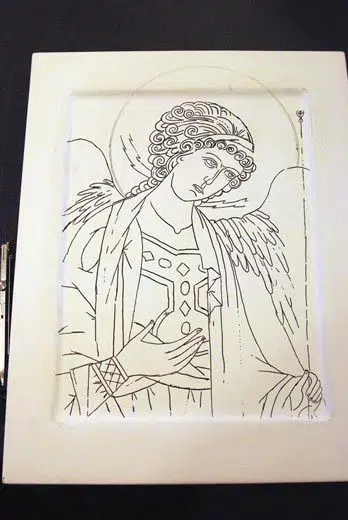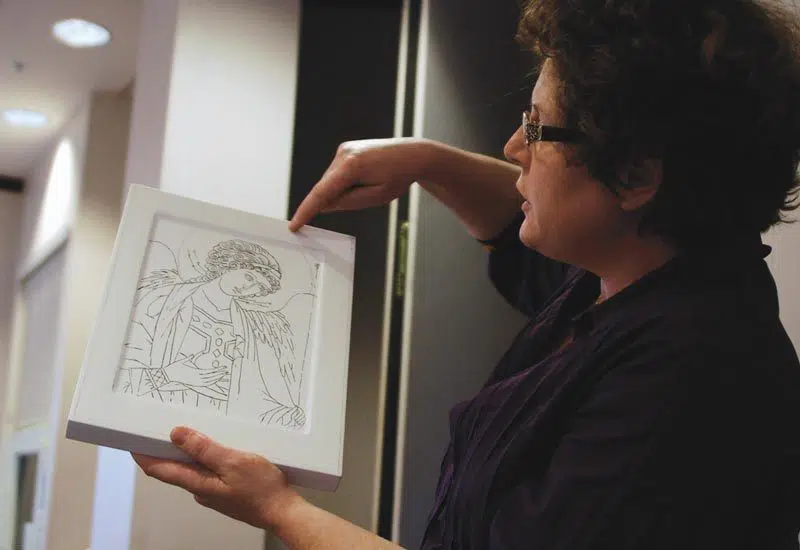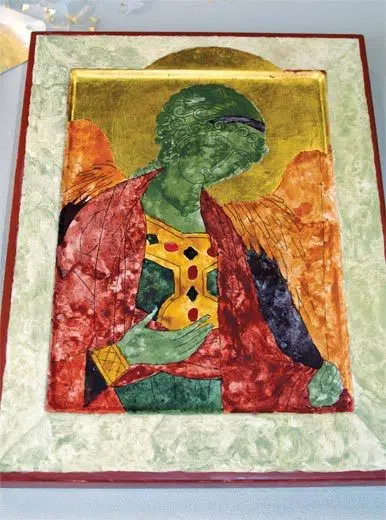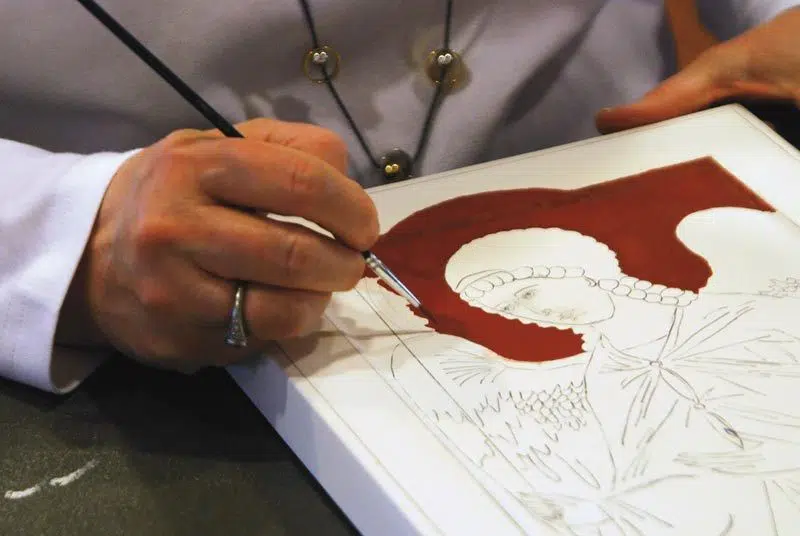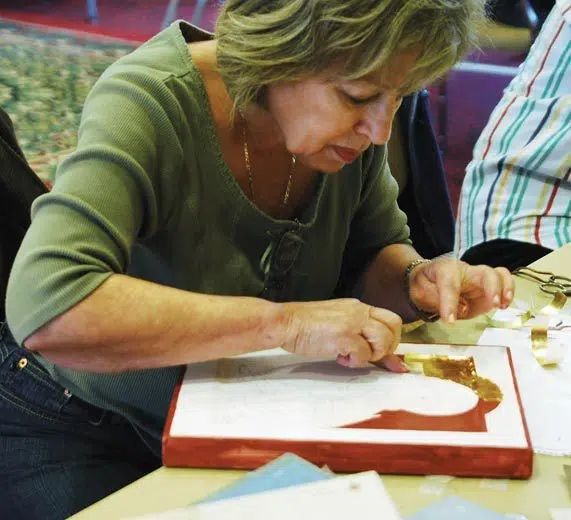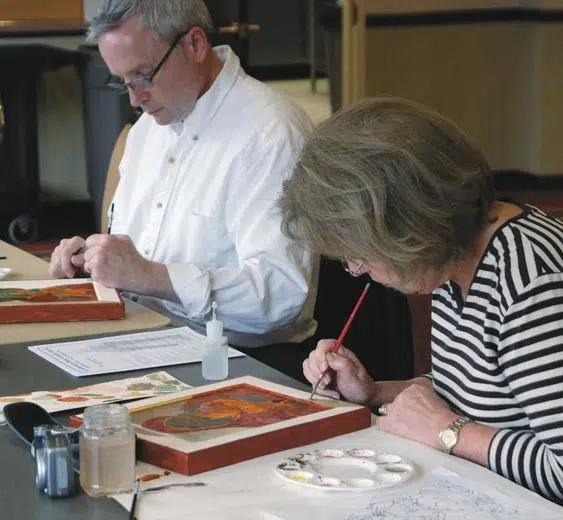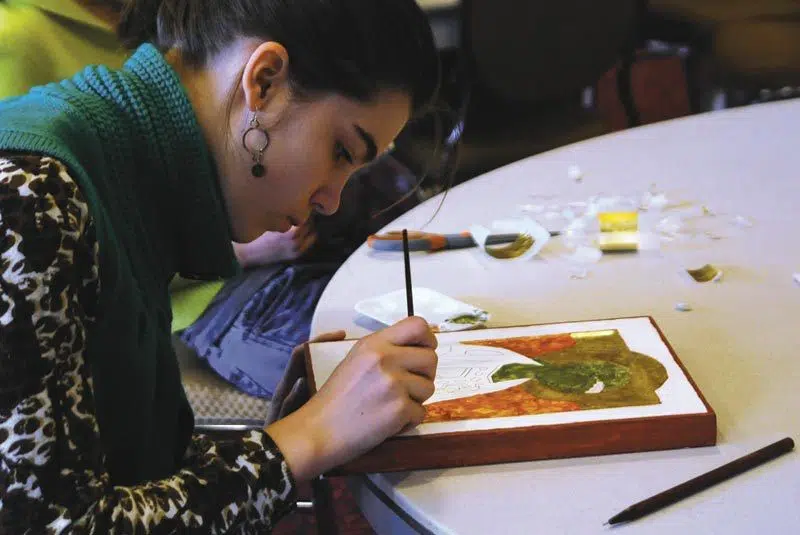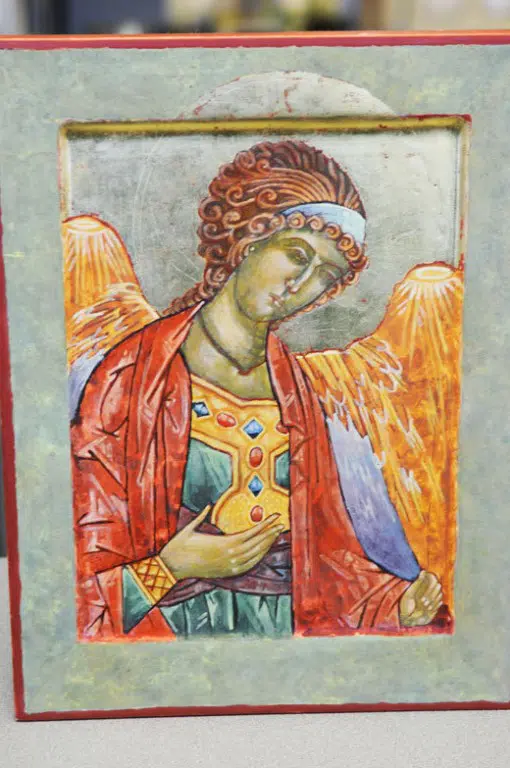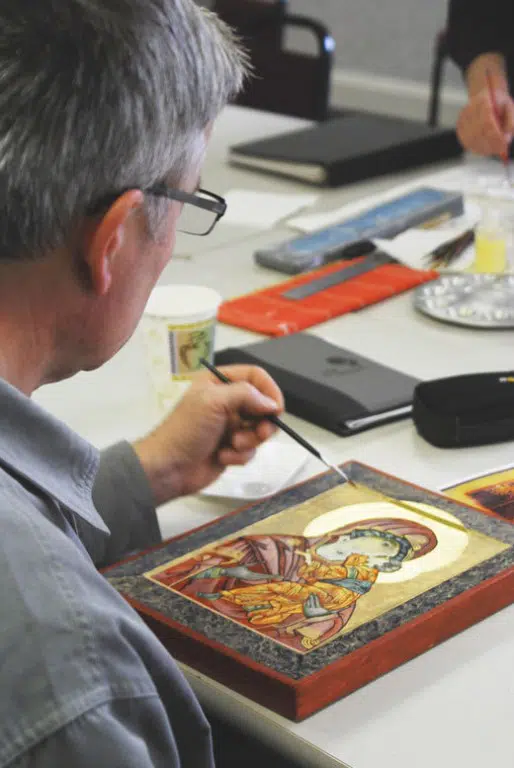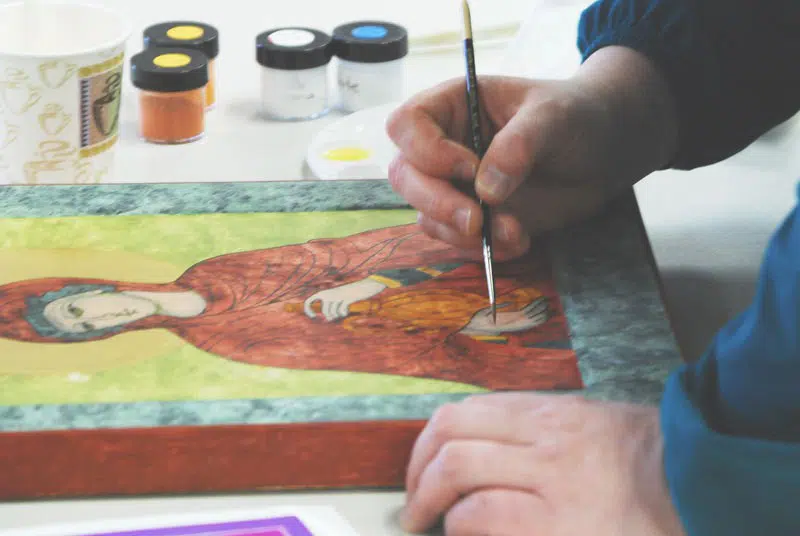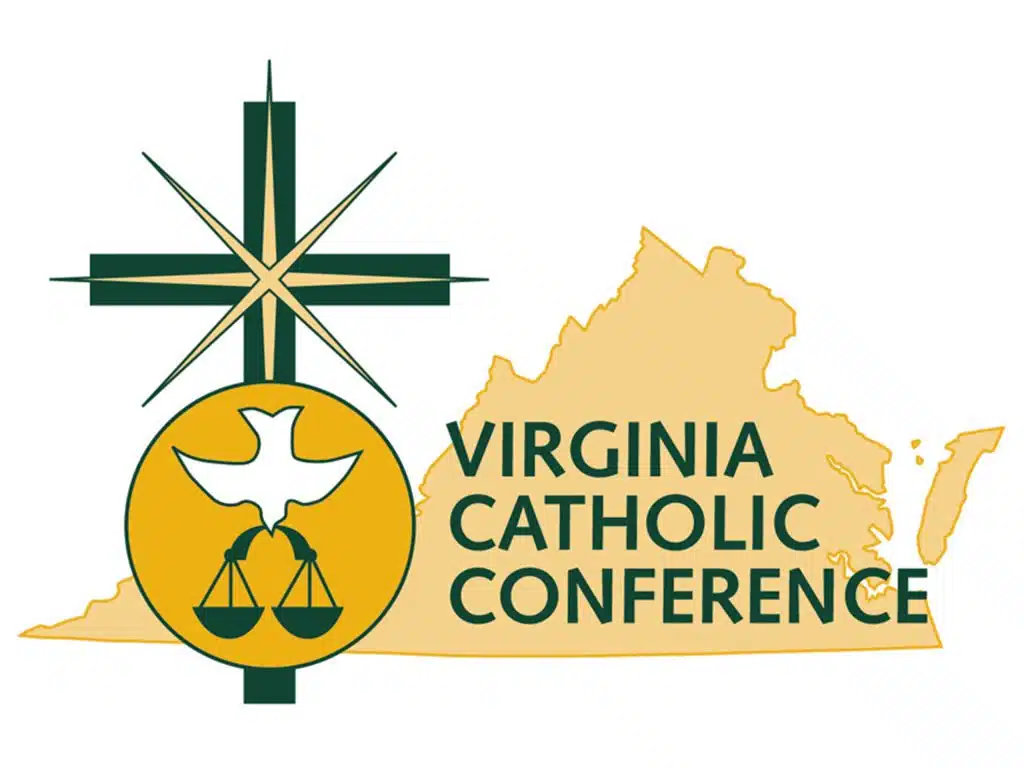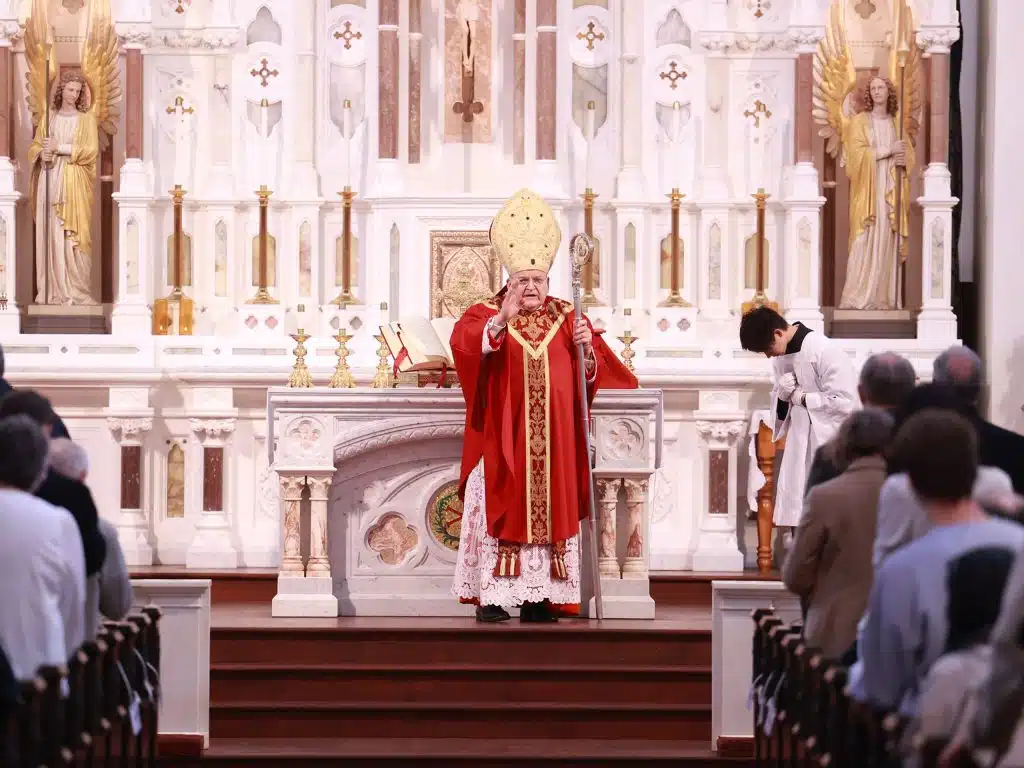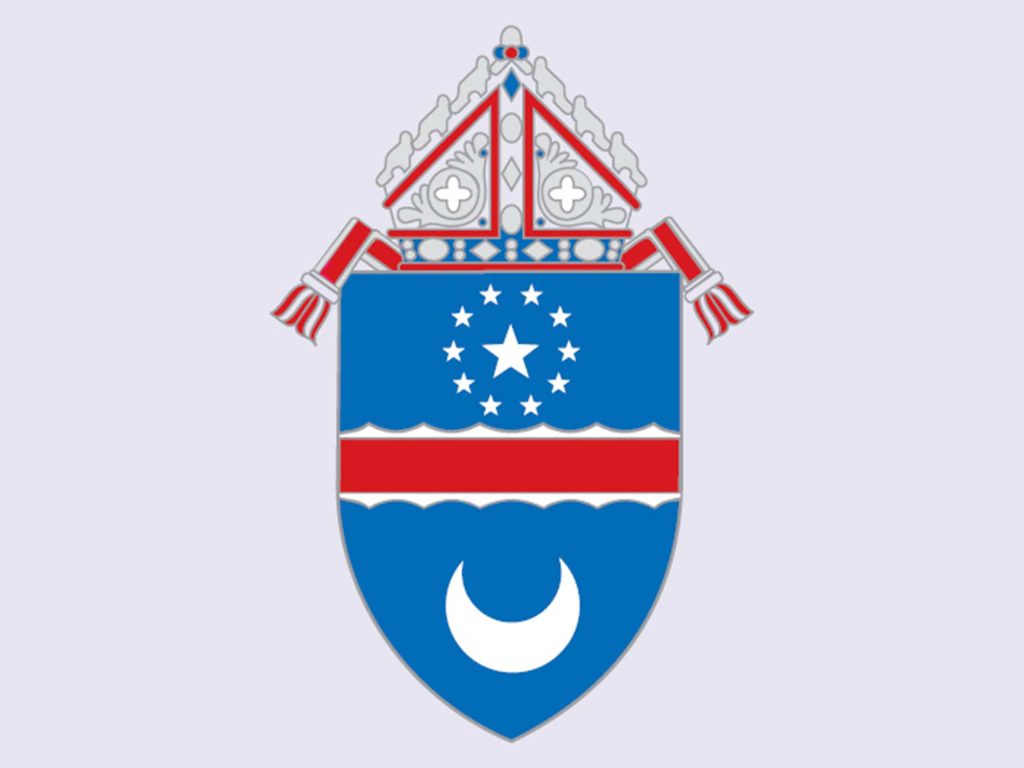You might already know what icons look like – found in
churches and museums around the world, they are religious
images of Jesus, Mary or a saint painted on wooden panels,
usually featuring golden halos. They are beautiful, but have
you ever stopped to think how they were made?
Participants in a recent icon painting workshop at St.
Catherine of Sienna Church in Great Falls could tell you. For
the last three weekends, they spent almost 40 hours learning
about pigments, religious symbolism and eggs – yes, eggs.
Such is the life of an icon painter.
Thousands of years old, iconography is a labor-intensive art
form with specific steps, that have been perfected over the
years.
First the icon is drawn onto the surface of a wooden board.
In the workshop, participants used carbon paper to trace the
pattern on the board. Then, the lines were etched into the
surface and areas that were to become gold were painted with
a layer of red bole, a type of clay. After being sanded and
polished, the bole became the foundation for the gold leaf,
which was carefully laid down one small piece at a time.
After the gold was in place, the icon was “opened” as the
base colors of egg tempera were painted on the face and
hands, and then everywhere. At this stage, the colors were
dark and one-dimensional. In the next stage, the “lights” –
lighter colors that add shape and volume to the icon – were
painted, with “floats” – transparent layers of color that
even everything out – being applied after each phase. These
lights and floats made it possible to have different hues of
the same color in the icon, giving it a more realistic and
three-dimensional appearance.
The whole process is time-consuming and tedious, and in order
to be effective, it cannot be rushed. The process is also
wrought with deeper meanings. Painting the icon is symbolic
for every individual’s journey toward sanctification. That is
why, for example, the paint is dark at first and gets lighter
at every level, to show a rising from sin.
“Each step in making the icon will have a different meaning,”
said iconographer Ioana Belcea, who taught the workshop. “At
each layer, the icon needs to be in harmony. As you move
further in your spiritual life, it is important to be in
harmony. Everything needs to be balanced.”
For Belcea, iconography has been her passion for the past
seven years. Having grown up Catholic in Romania, she had
fallen away from the Church for a while. After coming to the
United States when she was 16, she earned a degree in fine
arts at Rutgers University in New Jersey, but had never
worked as a professional artist.
“I thought there was too much garbage that people put forth
and I didn’t feel like I had anything to say, really,” she
said.
When her son was born, she started to come back to the Faith
and it wasn’t long before she felt the need to create art.
She found a book on iconography and started learning on her
own, but that was just the technical side of icons and she
wasn’t satisfied. Then her mother found an article about an
iconography workshop in Mystic, Conn., at the St. Michael
Institute of Art. Belcea left town for five days to attend.
“It was truly an eye-opener because all of a sudden
everything came together – my artistic background, my return
to the Church, it was intellectually challenging, which I had
found missing in my earlier years, and it was also extremely
rewarding, giving me tremendous insight into a world I didn’t
even know existed,” Belcea said.
After that, Belcea became passionate about learning
iconography and started taking weekend workshops with the
Russian iconographer Vladislav Andreyev at the Prosperon
School of Iconology in New York every few months.
“It was a very slow process,” Belcea said. “It went
hand-in-hand with my spiritual growth and I can really trace
every step of the way, both in the image and in my life.”
Among other things, Belcea said iconography has taught her
patience, discipline and trust in God. Because of her icons,
she has also done a good deal of reading on iconography,
theology, the Scriptures and the writings of the Early
Fathers of the Church.
“I found that as I went deeper into understanding
iconography, not only did I understand Catholicism and how
true it is and how everything in icons and dogma and the
teachings of the Church and so on, how much they are one,”
Belcea said.
Today, Belcea works as a professional iconographer, and has
made three pieces for St. Catherine of Siena Church. She now
hopes to pass on the lessons she learned to her own students
through her workshops. The most recent workshop was the fifth
she has taught in four years.
“I felt like educating people about icons would be a good
stepping stone in preparing them for the same liturgical art
and I also feel like there’s a responsibility where, if
you’re given much, you have to give back to the community,”
Belcea said. “I feel blessed to have been given so much by
the master I have, and this is my own parish, my own
community and I felt I should pass it on.”
During the workshop, Belcea spends a lot of time explaining
the significance of each step. This is one of the reasons why
many workshop participants choose to take part in the
workshop more than once.
“I like the combination of art and spirit,” said Cindy Laird,
who took Belcea’s workshop last year and has been working on
icons ever since, having already completed two.
“There’s something about the process of painting icons that
is very contemplative. It’s very God-centered.”
For Ruth McCully, the workshop this month marked her second
class.
“I really enjoyed it the first time – it allows an
opportunity to step back and step out of the world to another
place to focus on this,” McCully said. “Although we can be
lighthearted in the class, there’s still a lot of meaning as
we’re going through the process, so particularly at Lent, I
think it’s a great practice because it forces you to slow
down.”
Workshop participant Richard Fanelli also enjoyed the
spirituality involved in the icons.
“It helps you to develop inner calmness and it’s a beautiful
piece of artwork that you’re proud to hang on the wall,”
Fanelli said. “I like doing it during Lent because I feel
like it’s a Lenten exercise. It helps you focus on spiritual
things.”
While many people who join the class are not artistically
inclined, even the people who joined to learn about the
artistry found the spiritual aspect of the icons moving.
Mandy Hain said she wanted to learn from Belcea to be exposed
to the ancient techniques of egg tempera, in which egg yolks
are mixed with water and natural pigments to make paint. She
was impressed with the spiritual aspect of the icons.
“It really causes you to meditate on the state of your soul,”
Hain said.
“I think that each person gets something different from it,”
Belcea said. “Sometimes I find that I teach the class and I’m
actually teaching to one person because that one person
needed to hear what I had to say. The others enjoy it, but
that one person is transformed more than the others. That’s
why, when I prepare my classes, I always ask God to help me
put something together that is faithful to that moment.”
